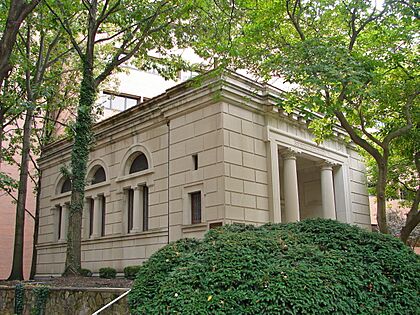Henry S. Frank Memorial Synagogue facts for kids
Quick facts for kids Henry S. Frank Memorial Synagogue |
|
|---|---|

The former synagogue, in 2010
|
|
| Religion | |
| Affiliation | Judaism |
| Rite | Nusach Ashkenaz |
| Ecclesiastical or organisational status | Synagogue |
| Location | |
| Location | 5501 Old York Road, Philadelphia, Pennsylvania 19141 |
| Country | United States |
| Architecture | |
| Architect(s) |
|
| Architectural type | Synagogue architecture |
| Architectural style | Classical Revival |
| Completed | 1901 |
| Materials | Limestone, granite, ceramic tiling |
The Henry S. Frank Memorial Synagogue is a historic synagogue building. It is located on the grounds of Jefferson Einstein Hospital in Philadelphia, Pennsylvania, United States.
The synagogue was built with a lot of money from Rose S. Frank. She named it to honor her husband, Henry S. Frank. He was a philanthropist, which means he was a person who gave money to good causes. Henry S. Frank passed away in 1887.
This special building was added to the National Register of Historic Places in 1983. This means it is recognized as an important historical site.
Contents
History of the Synagogue
Building a Unique Place
The Henry S. Frank Memorial Synagogue was finished in 1901. It was built on the land of what was then called the Jewish Hospital of Philadelphia. Today, this hospital is known as Jefferson Einstein Hospital.
What makes this synagogue very unique is its location. It is the only synagogue in the world known to be built right on hospital grounds.
Inspired by Ancient Designs
The main architect for the synagogue was Arnold W. Brunner. He got his ideas from old Roman-era synagogues found in Israel. He was especially inspired by the beautiful synagogue at Kfar Bar'am.
Experts from the British Palestine Exploration Fund had studied several of these ancient synagogues. They published pictures and drawings of them in a book called the Jewish Encyclopedia.
The Frank Memorial Synagogue copied some features from these ancient buildings. For example, the round arch over its door looks like the one from the ruins at Kfar Bar'am. The stone lintel, which is the beam above the doorway, was copied from a smaller synagogue at Kfar Bar'am. This original lintel is now in the Louvre museum.
Special Details and Meanings
The inscription on the lintel of the Frank Memorial Synagogue is in Hebrew. It says, "Peace be upon the place, and on all the places of Israel." This message was taken directly from the ancient lintel.
Above the door, you can see a seven-branched Menorah inside a wreath. A menorah is a special candelabrum used in Jewish ceremonies. This design was copied from the ancient Nabratein synagogue.
Inside the synagogue, the floors are decorated with mosaics. Mosaics are pictures or patterns made from small pieces of colored stone or glass. This was a very interesting choice because, at the time the synagogue was built, ancient mosaic synagogue floors had not yet been discovered in Israel.
The supervising architect for the project was Frank Furness. He had been the main architect for the Jewish Hospital since 1871.
See also



